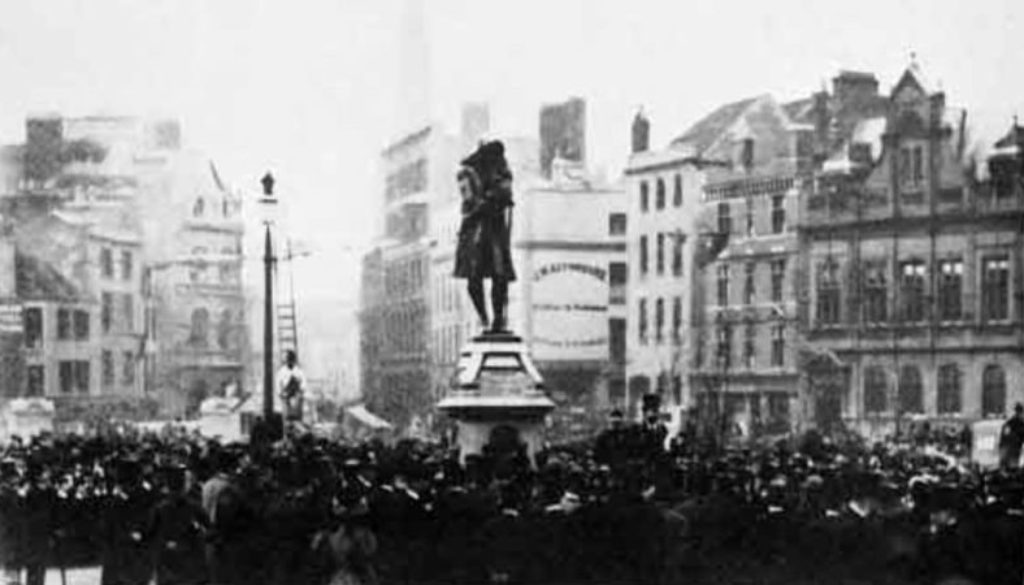Statues

I sent this to the Guardian but they did not reply.
Scandalous statues in Bristol and anywhere
The toppling in Bristol of the bronze statue of Edward Colston, slave trader and major benefactor (or should it be benefactor and major slave trader?) raises complex issues, and my own opinion has changed somewhat in the light of recent events.
My instinct as an art historian is not to approve of the destruction / vandalism of a work of art – though in truth the statue by John Cassidy of Manchester in does not rise above the competent. We obviously should not decide such an issue on the basis of its perceived quality of a work of art. BUT there is a memorial to Colston in the decommissioned church of All Saints in Bristol. It was designed by the excellent architect James Gibbs (Church of St. Martin’s in the Fields etc.) with a funeral effigy by John Michael Rysbrack, as good a sculptor as there was in Britain at that time. With such an artistic pedigree, do we protect the memorial while not regretting (too much) the fall of Cassidy’s routine bronze? There’s also a fine swagger portrait of Colston by Jonnathan Richardson, previously in the Mayor’s office (present location withheld). Do we slash it with a sharp instrument?
There are long historical antecedents to acts of destruction. Our churches and collections of Mediaeval art bear vivid witness to the iconoclastic destruction of “papist” images. The issue of “graven” images runs as a centuries-old sore across the various Christian denominations. Such British pre-Reformation images as still survive are now likely to admired in historic venues and museums administred by non-Catholics. We may also recall the dynamiting of the very giant Buddhas of Bamiyan by the Taliban in 2001. That was a World Heritage Site. There is a huge number of such events, which we are now likely to denounce.
I have tended to think that statues of people who incite our disapproval in whole or in part are an integral part of the historic fabric of a place, which cannot be productively re-modelled, and that it is best that they are seen to serve as memorials to values that we no longer espouse. However these matters are complicated and not readily subject to a simple formula.
Let us take as an example the vandalism in 2017 of statue of the pioneer gynaecologist, J. Marion Sims , and its subsequent removal from its pedestal on the edge of New York’s Central Park. It was taken to the cemetery where Sims is buried. Sims’s “experiments’ on black women are taken as outweighing his apparent virtues, as measured on today’s scales. But let’s look at Central Park itself, one of the signature assets of the Big Apple. To create it in 1857 about 16,000 people were involuntarily displaced, and schools, churches, a convent and residential village were destroyed. As we might suspect, the residents were mainly black. Do we renounce Central Park? Do we return the sites to the descendants of the displaced?
Many of our valued places, institutions and artworks were bankrolled by money that we would now regard us unclean, including not a few Oxbridge Colleges – and good number of Renaissance masterpieces.
My answer was that we should not hide the past and that it is better to know about it than deny it. Education, in this case, is the conventional answer. Now I am not so sure.
The erecting a public monument is political-cum-social act. Removing it is a legitimate response to the original act. I say “removal” very deliberately not destruction. The statues are mute but visually eloquent witnesses to our history and our deployment of art in the service of causes that we have (or should have) long since abandoned. Local solutions should be found as to where to re-locate them, ideally where they can serve an active cultural role. The empty plinths, like that in Trafalgar Square, can support major works by contemporary artists. Let’s build something new on the debris of what we now regard as shameful attitudes.
Two footnotes.
1. For 99% of the time no-one notices the statues, unless they portray someone very famous like Churchill. They are just part of the urban scenery.
2. It is interesting that a bronze effigies of largely forgotten, eldery white men can still be invested with such presence and meaning when the occasion arises.
For Central Park, see Sarah Waxman
https://www.ny.com/articles/centralpark.html
July 9, 2020 @ 3:21 pm
Dear Dr. Kemp,
Thanks for your insight. One idea I wonder about how futile the conception / or ideals of a monument can be in the first place, as the creation of a monument's value / significance is prone towards becoming anachronistic / or reinterpreted despite the efforts of its makers to create a symbol that transcends time and place. You mention the history Central Park as a great counterpoint to outcries of those symbols of minority oppression, perhaps then, the way to frame this discussion could be to think about how our public spaces serve the greater community at large? Weighing their current civic utility against their illicit histories might be a productive way of reconciling with the past and deciding what values we want to take from such spaces moving forward. Perhaps a divisive issue as such could be an opportunity for cohesion in the end. Interested to hear your thoughts..
July 11, 2020 @ 1:17 pm
Thank you. Very thoughtful .
One of the characteristics of visual images is that the commissioners / makers cannot control the meanings attached to them, least of all over the period of time. It's worth askingi if the memorialising of 'great' people (men) is really necessary. It serves the values of those who are dominant at any one time. We could move them all into a special viewing area and use the plinths like the one of Trafalgar Square, with works by a sucession of artists.